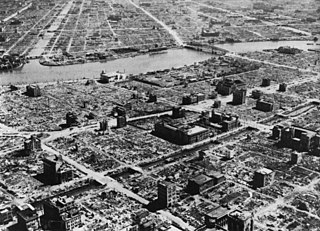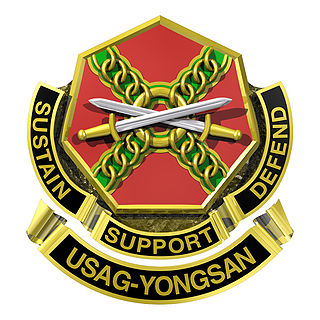Related Research Articles

The Boeing B-29 Superfortress is an American four-engined propeller-driven heavy bomber, designed by Boeing and flown primarily by the United States during World War II and the Korean War. Named in allusion to its predecessor, the B-17 Flying Fortress, the Superfortress was designed for high-altitude strategic bombing, but also excelled in low-altitude night incendiary bombing, and in dropping naval mines to blockade Japan. B-29s dropped the atomic bombs on Hiroshima and Nagasaki, the only aircraft ever to drop nuclear weapons in combat.

Strategic bombing is a systematically organized and executed attack from the air which can utilize strategic bombers, long- or medium-range missiles, or nuclear-armed fighter-bomber aircraft to attack targets deemed vital to the enemy's war-making capability. It is a military strategy used in total war with the goal of defeating the enemy by destroying its morale, its economic ability to produce and transport materiel to the theatres of military operations, or both. The term terror bombing is used to describe the strategic bombing of civilian targets without military value, in the hope of damaging an enemy's morale.

The bombing of Tokyo was a series of air raids on Japan launched by the United States Army Air Forces during the Pacific Theatre of World War II in 1944–1945, after the attack on Pearl Harbor, and prior to the atomic bombings of Hiroshima and Nagasaki.

Yongsan Garrison, meaning "dragon hill garrison", is an area located in the Yongsan District of central Seoul, South Korea. The site served as the headquarters for U.S. military forces stationed in South Korea, known as United States Forces Korea (USFK), and as United States Army Garrison Yongsan (USAG-Yongsan) until 2018, under the supervision of the U.S. Army's Installation Management Command Pacific Region. From 1910 to 1945 it served as headquarters for the Imperial Japanese Army in Korea.

Yongsan Station is a major railway station in the Yongsan District of Seoul, South Korea. The station adjoins the Yongsan Electronics Market. The station is the terminus for high-speed and long-distance trains on a number of railway lines, including most trains on the Honam Line, its high-speed counterpart, and all trains on the Janghang and Jeolla Lines.

The Twentieth Air Force (Air Forces Strategic) (20th AF) is a numbered air force of the United States Air Force Global Strike Command (AFGSC). It is headquartered at Francis E. Warren Air Force Base, Wyoming.

During the Pacific War, Allied forces conducted air raids on Japan from 1942 to 1945, causing extensive destruction to the country's cities and killing between 241,000 and 900,000 people. During the first years of the Pacific War these attacks were limited to the Doolittle Raid in April 1942 and small-scale raids on military positions in the Kuril Islands from mid-1943. Strategic bombing raids began in June 1944 and continued until the end of the war in August 1945. Allied naval and land-based tactical air units also attacked Japan during 1945.

General Emmett E. "Rosie" O'Donnell Jr. was a United States Air Force four-star general who served as Commander in Chief, Pacific Air Forces (CINCPACAF) from 1959 to 1963. He also led the first B-29 Superfortress attack against Tokyo during World War II.

Wonhyoro-dong (Korean: 원효로동) is a dong (neighbourhood) of Yongsan District, Seoul, South Korea.

Sogong-dong (Korean: 소공동) is a dong (neighborhood) of Jung District, Seoul, South Korea.
Mugyo-dong (Korean: 무교동) is a legal dong (neighbourhood) of Jung District, Seoul, South Korea. It is governed by its administrative dong, Myeong-dong.

The 19th Operations Group is the operational flying component of the United States Air Force 19th Airlift Wing, stationed at Little Rock Air Force Base, Arkansas.

The United States Air Force in South Korea is composed of units assigned to Pacific Air Forces Seventh Air Force. The mission of the personnel, equipment and aircraft is to deter, protect and defend the Republic of Korea from attack from the Democratic People's Republic of Korea (DPRK) or more commonly known as North Korea.

The bombing of Yawata on the night of 15–16 June 1944 marked the beginning of the United States Army Air Forces (USAAF) strategic bombing campaign against the Japanese home islands during the Pacific War and was the first such raid to employ strategic bombers. The raid was undertaken by 75 Boeing B-29 Superfortress heavy bombers staging from bases in China. Only 47 of these aircraft dropped bombs near the raid's primary target, the Imperial Iron and Steel Works at Yawata in northern Kyūshū, and little damage was caused. Five B-29s were lost in accidents during the operation and two were destroyed by Japanese aircraft.
The Air Battle of South Korea was an air campaign early in the Korean War occurring roughly from 25 June to 20 July 1950 over South Korea between the air forces of North Korea and the United Nations, including the countries of South Korea, the United States and the United Kingdom. The month-long fight for air supremacy over the country included several small engagements over airfields in Seoul and Taejon and ultimately ended in victory for the UN air force, which was able to destroy the small North Korean People's Air Force.

The Goyang Geumjeong Cave massacre was a massacre of over 153 unarmed civilians conducted between 9 October 1950 and 31 October 1950 by police in Goyang, Gyeonggi-do district of South Korea. After the victory of the Second Battle of Seoul, South Korean authorities arrested and summarily executed several individuals along with their families on suspicion of sympathizing with North Korea. The killings in Goyang coincided with the Namyangju massacre in nearby Namyangju.

The No Gun Ri massacre was a mass killing of South Korean refugees by U.S. military air and ground fire near the village of Nogeun-ri (노근리) in central South Korea between July 26 and 29, 1950, early in the Korean War. In 2005, a South Korean government inquest certified the names of 163 dead or missing and 55 wounded, and added that many other victims' names were not reported. The No Gun Ri Peace Foundation estimates 250–300 were killed, mostly women and children.
The bombing of Pyongyang was conducted as part of a gradual and sustained United Nations Command aerial bombing of North Korea during the Korean War. The first bombing raid targeting Pyongyang occurred on June 29 1950, four days after North Korea's invasion of South Korea. By the time of the armistice in July 1953, 75 percent of Pyongyang's area had been destroyed.

Following the North Korean invasion of South Korea in June 1950, air forces of the United Nations Command began an extensive bombing campaign against North Korea that lasted until the end of the Korean War in July 1953. It was the first major bombing campaign for the United States Air Force (USAF) since its inception in 1947 from the United States Army Air Forces. During the campaign, conventional weapons such as explosives, incendiary bombs, and napalm destroyed nearly all of the country's cities and towns, including an estimated 85% of its buildings.

On the night of 9/10 March 1945, the United States Army Air Forces (USAAF) conducted a devastating firebombing raid on Tokyo, the Japanese capital city. This attack was code-named Operation Meetinghouse by the USAAF and is known as the Tokyo Great Air Raid in Japan. Bombs dropped from 279 Boeing B-29 Superfortress heavy bombers burned out much of eastern Tokyo. More than 90,000 and possibly over 100,000 Japanese people were killed, mostly civilians, and one million were left homeless, making it the most destructive single air attack in human history. The Japanese air and civil defenses proved largely inadequate; 14 American aircraft and 96 airmen were lost.